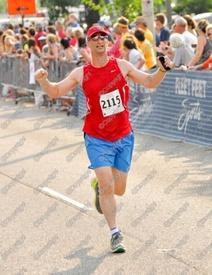What is the importance of knowing your heart rate?
Options

soccerkon26
Posts: 596 Member
Obviously we need a heart beat to live...but what is the importance of knowing your heart rate?
I just got a Fitbit charge HR and have found out my resting heart rate is about 60 and my highest heart rate when working out is about 180.
I am young and healthy, so does my heart rate really matter?
Thanks
I just got a Fitbit charge HR and have found out my resting heart rate is about 60 and my highest heart rate when working out is about 180.
I am young and healthy, so does my heart rate really matter?
Thanks
0
Replies
-
Barring medical issues, you really don't need to know it.0
-
It helps if you are aiming to improve cardio fitness so being able to get your heart rate up and sustaining it at that elevated level will increase your fitness level. Having numbers to aim for gives you a good indication of where you stand. Otherwise, it is not necessary to know it unless you need to monitor it for health issues.0
-
Some will tell you that knowing your HR can help improve the reliability of your calorie burns, but this isn't *usually* the case.
Knowing your HR can help with certain types of HR-based training, but that doesn't apply to most MFPers.
By and large, it's another data point, which data junkies like myself enjoy analyzing. But in the end, it doesn't usually mean that much.0 -
You don't need it
But I use it throughout my workouts and it really chaps my hyde when the thing craps out on me and displays 00 or "check heart rate transmitter".
I like it for feedback during the workout. On days I'm being lazy and whiny and I think I'm working oh so hard but my heart rate is just in the 150's, it nudges me to quit whining and do a bit more. When I'm really killin it, I do like to see my heart rate up there. For interval type exercises I just like seeing the feedback throughout all the way from warm up low to doubled over high
But no, I wouldn't say you have to have it in order to exercise effectively 0
0 -
Training at different intensities help improve different aspects of your fitness. Different intensity zones are many times defined by a percentage of your maximum heart rate.
Something the general population aren't really interested in normally and are reserved for the more serious athletes.
It is a great way to track fitness improvements.
For example: 3 months ago it took such and such amount of effort to raise my heart rate to XX and now I have to work this much harder to get it to that heart rate. Also, as your fitness improves your resting heart rate should drop.0 -
There are uses for knowing your heart rate.
Your fitbit will use that information during a workout to more accurately calculate calories burned (provided all of your information is kept up to date (weight, resting heart rate, max heart rate).
Heart rate is also very important when exercising. You can workout in different heart rate zones for different lengths of time to get different training results (steady state, tempo, maximum, and even recovery).
If you exercise, heart rate is a very important factor, and very useful tool to reach fitness goals.
In cardio, heart rate and time are the two major factors to determine training effect.0 -
Training at different intensities help improve different aspects of your fitness. Different intensity zones are many times defined by a percentage of your maximum heart rate.
THIS times a million!
If you don't know your zones, here's a quick and easy guide.
1. Old lady pace
2. Chatty pace
3. Feel good hard
4. Feel bad hard
5. I am going to die
6. Flat out
My guess is that the OP's HR of 180 is probably up in Zone 4, 5 or 6 and could not be maintained for a very long duration compared to Zone 1, 2 and 3. My comments are based on Coggan's 6 training zones which is a pretty commonly used system for runners/cyclists.
Google Coggan's training zones to learn more.0 -
SingingSingleTracker wrote: »Training at different intensities help improve different aspects of your fitness. Different intensity zones are many times defined by a percentage of your maximum heart rate.
THIS times a million!
If you don't know your zones, here's a quick and easy guide.
1. Old lady pace
2. Chatty pace
3. Feel good hard
4. Feel bad hard
5. I am going to die
6. Flat out
My guess is that the OP's HR of 180 is probably up in Zone 4, 5 or 6 and could not be maintained for a very long duration compared to Zone 1, 2 and 3. My comments are based on Coggan's 6 training zones which is a pretty commonly used system for runners/cyclists.
Google Coggan's training zones to learn more.
Are you talking about power zones?
I think there are only 5 heart rate zones.0 -
bcalvanese wrote: »SingingSingleTracker wrote: »Training at different intensities help improve different aspects of your fitness. Different intensity zones are many times defined by a percentage of your maximum heart rate.
THIS times a million!
If you don't know your zones, here's a quick and easy guide.
1. Old lady pace
2. Chatty pace
3. Feel good hard
4. Feel bad hard
5. I am going to die
6. Flat out
My guess is that the OP's HR of 180 is probably up in Zone 4, 5 or 6 and could not be maintained for a very long duration compared to Zone 1, 2 and 3. My comments are based on Coggan's 6 training zones which is a pretty commonly used system for runners/cyclists.
Google Coggan's training zones to learn more.
Are you talking about power zones?
I think there are only 5 heart rate zones.
You can use a 5 HR training zone system. There are, in theory, 6. Depends on if you are reading Coggan or others.
Here's Coggan...
Heart Rate Zone.....Percent of LTHR
Active Recovery ......<68% LTHR
Endurance..............68% to 83%
Tempo....................83% to 94%
Sweet Spot..............94% to 95%
Threshold...............95% to 105%
VO2Max.................105% to 220 BPM
Here's an "other"...
Heart Rate Zones:
Zone 1 = Recovery (<71% of AT) – uses the aerobic system
Zone 2 = Endurance (72-81% of AT) – uses the aerobic system
Zone 3 = Tempo Pace (82-91% of AT) – uses mainly aerobic system
Zone 4 = Threshold Pace ( 92-102% of AT) – uses mainly aerobic system with some anaerobic system
Zone 5 = Anaerobic Pace (103-110% of AT) – covers zone where aerobic converts to the anaerobic system.
Zone 6 = Maximum aerobic capacity (Too short to record HR) – anaerobic and CP systems
And yet another "other"...
http://www.bikeradar.com/us/gear/article/heart-rate-monitor-training-for-cyclists-28838/
HR zones
Having established the key numbers (max HR and resting HR) you're now ready to work out your training zones. There are lots of calculators on the web and, while many people use five training zones, I prefer the six-zone system prescribed by the Association of British Cycling Coaches. Fletcher is also a big fan of the six zones, although he points out that there is actually a recovery zone as well which is important. “If athletes are to perform well they need to recover well,” he says. “I monitor every session my athletes do and I can tell very easily when they need to recover and how long that recovery needs to be.”
Zone 1 (60-65% of maximum heart rate): For long, easy rides, to improve the combustion and storage of fats.
Zone 2 (65-75% of MHR): The basic base training zone. Longish rides of medium stress.
Zone 3 (75-82% of MHR): For development of aerobic capacity and endurance with moderate volume at very controlled intensity.
Zone 4 (82-89% of MHR): For simulating pace when tapering for a race.
Zone 5 (89-94% of MHR): For raising anaerobic threshold. Good sessions for 10- and 25-mile time-trials.
Zone 6 (94-100% of MHR): For high-intensity interval training to increase maximum power and speed0 -
It's a data collection tool. How you use that data is up to you. For me, I like it to track my fitness progress. For example: My heart rate used to go up to 154 on a 3.5 mph flat brisk walk, now it only goes up to 136 walking at the same speed. Seeing progress that can be represented in numbers makes my results more tangible and prompts me that I'm ready to increase the average intensity of my exercise (incline in my case). I have also noticed that if my heart rate goes beyond a certain point I need a longer recovery and I can't perform as well the next day, plus I get extremely hungry afterwards, so I try to keep my intensity in check not to overdo it.0
-
This content has been removed.
-
Even tho you are young, if you overwork your heart for prolonged periods of time it could affect you later on. It's important to know your body, and recognize when it's too much work for it to handle. For a lot of people it helps knowing heartrate to do so. I would say tho, if you are good in listening to your own body, and know when to stop, knowing your heart rate is not crucial.0
-
Yeah, it's some data regarding heart and vascular health, just like blood pressure is.
A RHR of 60 is the very bottom of the normal range, but it's common for those who are in good shape to be on the low end, and even into the 50s or 40s for elite athletes, because as the heart becomes stronger from cardiovascular training, it moves more blood with each beat and beats less often as a result.
Tracking your resting heart rate changes as you go through a cardiovascular training program can help you see your results - in general if your resting heart rate goes down over time but you feel fine, it just means your heart is getting stronger from exercise. In that sense, a low heart rate can often be a good sign. It would be a bad sign if you experienced symptoms like fainting, shortness of breath, or if your heart rate was very low for your activity level. For example, a heart rate of 50 for someone totally sedentary is probably a bad sign, but for someone who is very active and feeling great, it's probably a good one. 60 BPM is a good resting heart rate for someone of good cardiac fitness.
It's good to establish a baseline for what is normal for you, so you and your doctor can discuss what any major changes mean.
Heart Rate Recovery was mentioned, too. That means you get your heart rate up to 80% of maximum or so by a burst of intense exercise, and then you stop and sit down and calmly rest, and see how far your heart rate will fall in 2 minutes. The bigger the drop, the better your cardiovascular fitness. A drop of less than 20 beats per minute is abnormally low (and indicates a higher risk of cardiac events), a drop of 20-50 is pretty normal, and beyond 50 indicates good cardiovascular health, with higher recovery rates being indicative of even better health.0 -
You all are awesome! Thanks so much
 0
0 -
@SingingSingleTracker
Exactly on track
OP
If you are training there is the need to know you heart rate. There is a different HRM for cycling and running.
If you are burning calories and just doing some cardio burn, knowing what you are doing and why you are doing it won't hurt.
Knowing which type of fuel your body gravitates toward at certain intensity levels is good too.
If you plan to make fitness a lifestyle change then learning about heart rates is more knowledge to empower yourself with.0 -
-
Some will tell you that knowing your HR can help improve the reliability of your calorie burns, but this isn't *usually* the case.
Knowing your HR can help with certain types of HR-based training, but that doesn't apply to most MFPers.
By and large, it's another data point, which data junkies like myself enjoy analyzing. But in the end, it doesn't usually mean that much.
Agree with all of this. Oddly enough, I find my HRM most useful when I am doing endurance training. I have a tendency to get bored and want to push it, so the HRM helps me keep it low and slow.
0 -
SingingSingleTracker wrote: »bcalvanese wrote: »SingingSingleTracker wrote: »Training at different intensities help improve different aspects of your fitness. Different intensity zones are many times defined by a percentage of your maximum heart rate.
THIS times a million!
If you don't know your zones, here's a quick and easy guide.
1. Old lady pace
2. Chatty pace
3. Feel good hard
4. Feel bad hard
5. I am going to die
6. Flat out
My guess is that the OP's HR of 180 is probably up in Zone 4, 5 or 6 and could not be maintained for a very long duration compared to Zone 1, 2 and 3. My comments are based on Coggan's 6 training zones which is a pretty commonly used system for runners/cyclists.
Google Coggan's training zones to learn more.
Are you talking about power zones?
I think there are only 5 heart rate zones.
You can use a 5 HR training zone system. There are, in theory, 6. Depends on if you are reading Coggan or others.
Here's Coggan...
Heart Rate Zone.....Percent of LTHR
Active Recovery ......<68% LTHR
Endurance..............68% to 83%
Tempo....................83% to 94%
Sweet Spot..............94% to 95%
Threshold...............95% to 105%
VO2Max.................105% to 220 BPM
Here's an "other"...
Heart Rate Zones:
Zone 1 = Recovery (<71% of AT) – uses the aerobic system
Zone 2 = Endurance (72-81% of AT) – uses the aerobic system
Zone 3 = Tempo Pace (82-91% of AT) – uses mainly aerobic system
Zone 4 = Threshold Pace ( 92-102% of AT) – uses mainly aerobic system with some anaerobic system
Zone 5 = Anaerobic Pace (103-110% of AT) – covers zone where aerobic converts to the anaerobic system.
Zone 6 = Maximum aerobic capacity (Too short to record HR) – anaerobic and CP systems
And yet another "other"...
http://www.bikeradar.com/us/gear/article/heart-rate-monitor-training-for-cyclists-28838/
HR zones
Having established the key numbers (max HR and resting HR) you're now ready to work out your training zones. There are lots of calculators on the web and, while many people use five training zones, I prefer the six-zone system prescribed by the Association of British Cycling Coaches. Fletcher is also a big fan of the six zones, although he points out that there is actually a recovery zone as well which is important. “If athletes are to perform well they need to recover well,” he says. “I monitor every session my athletes do and I can tell very easily when they need to recover and how long that recovery needs to be.”
Zone 1 (60-65% of maximum heart rate): For long, easy rides, to improve the combustion and storage of fats.
Zone 2 (65-75% of MHR): The basic base training zone. Longish rides of medium stress.
Zone 3 (75-82% of MHR): For development of aerobic capacity and endurance with moderate volume at very controlled intensity.
Zone 4 (82-89% of MHR): For simulating pace when tapering for a race.
Zone 5 (89-94% of MHR): For raising anaerobic threshold. Good sessions for 10- and 25-mile time-trials.
Zone 6 (94-100% of MHR): For high-intensity interval training to increase maximum power and speed
Holy crap that's complicated!
I just use the 5 zone because they are even numbers.
50-60
60-70
70-80
80-90
90-100
I mainly stay in zones 3/4 (zone 5 for shot times) for moderate to extreme workouts, and I use zones 1/2 for recovery workouts. Seems to work well for me, but I am not even close to an athlete. I'm just a regular old guy looking for the fountain of middle age... 0
0 -
My Fitbit HR says my resting HR is 56 after wearing it 2 days Im 350
-
For me, knowing HR has been a great training tool, especially when combined with the speed or power data on the bike or elliptical. Learning what numbers it takes to make my heart rate rise, understanding when not to waste energy, and knowing my thresholds on pace, comfort, and length of those two put me much closer to being able to hit my workouts hard when I want to. Using HRM also keeps me more mindful of what things will artificially or otherwise raise my HR when it's not really a direct energy output cause.
I think for cardio knowing heart rate is really a solid training point, and takes a lot of guesswork out of the picture.
0 -
SingingSingleTracker wrote: »If you don't know your zones, here's a quick and easy guide.
1. Old lady pace
2. Chatty pace
3. Feel good hard
4. Feel bad hard
5. I am going to die
6. Flat out
Your guide demonstrates how many people don't need to monitor HR and can instead monitor their perceived level of exertion. 0
0 -
Cherimoose wrote: »SingingSingleTracker wrote: »If you don't know your zones, here's a quick and easy guide.
1. Old lady pace
2. Chatty pace
3. Feel good hard
4. Feel bad hard
5. I am going to die
6. Flat out
Your guide demonstrates how many people don't need to monitor HR and can instead monitor their perceived level of exertion.
I don't know, brain is a tricky thing sometimes. The other day I did not feel like working out because it's a time of relaxing and holidays, but I did it anyway. During my run I felt like I was flatout going to die and that I was pushing so damn hard, but then I looked at my heart rate and found it to be in the high 140s. That's usually a 5 for me on this scale but it felt like a 9. The number helped me realize that my mind was being whiney and playing tricks on me because I didn't want to workout, and surely enough I was able to maintain the pace for the entire 30 minutes. Had I relied on perceived level of exertion alone I would have been in active recovery instead of my intended endurance pace.
I guess it doesn't really matter, but some people are empowered and motivated by data, so it's a good tool to use. Do you absolutely need it? No. Is it helpful to some? Absolutely yes.0 -
amusedmonkey wrote: »Cherimoose wrote: »SingingSingleTracker wrote: »If you don't know your zones, here's a quick and easy guide.
1. Old lady pace
2. Chatty pace
3. Feel good hard
4. Feel bad hard
5. I am going to die
6. Flat out
Your guide demonstrates how many people don't need to monitor HR and can instead monitor their perceived level of exertion.
I don't know, brain is a tricky thing sometimes. The other day I did not feel like working out because it's a time of relaxing and holidays, but I did it anyway. During my run I felt like I was flatout going to die and that I was pushing so damn hard, but then I looked at my heart rate and found it to be in the high 140s. That's usually a 5 for me on this scale but it felt like a 9. The number helped me realize that my mind was being whiney and playing tricks on me because I didn't want to workout, and surely enough I was able to maintain the pace for the entire 30 minutes. Had I relied on perceived level of exertion alone I would have been in active recovery instead of my intended endurance pace.
I guess it doesn't really matter, but some people are empowered and motivated by data, so it's a good tool to use. Do you absolutely need it? No. Is it helpful to some? Absolutely yes.
But maybe, it felt hard for a totally valid reason (e.g. missing sleep, recovering from yesterday's workout, not enough fuel, etc.), and your body was right to ease back a bit that day.0 -
amusedmonkey wrote: »Cherimoose wrote: »SingingSingleTracker wrote: »If you don't know your zones, here's a quick and easy guide.
1. Old lady pace
2. Chatty pace
3. Feel good hard
4. Feel bad hard
5. I am going to die
6. Flat out
Your guide demonstrates how many people don't need to monitor HR and can instead monitor their perceived level of exertion.
I don't know, brain is a tricky thing sometimes. The other day I did not feel like working out because it's a time of relaxing and holidays, but I did it anyway. During my run I felt like I was flatout going to die and that I was pushing so damn hard, but then I looked at my heart rate and found it to be in the high 140s. That's usually a 5 for me on this scale but it felt like a 9. The number helped me realize that my mind was being whiney and playing tricks on me because I didn't want to workout, and surely enough I was able to maintain the pace for the entire 30 minutes. Had I relied on perceived level of exertion alone I would have been in active recovery instead of my intended endurance pace.
I guess it doesn't really matter, but some people are empowered and motivated by data, so it's a good tool to use. Do you absolutely need it? No. Is it helpful to some? Absolutely yes.
But maybe, it felt hard for a totally valid reason (e.g. missing sleep, recovering from yesterday's workout, not enough fuel, etc.), and your body was right to ease back a bit that day.
If that was the case, my perceived level of exertion wouldn't have changed back to normal once I realized I was not going as hard as I thought. It's a personal thing, but I often confuse "I don't want to" with "I can't".0 -
Resting HR gives me an indication of my fitness level. (That's probably useful/interesting for many people.)
Ditto for speed of recovery.
Knowing my actual max HR gives me confidence to push harder knowing I'm not about to expire on a long hill. My max is higher than the standard formula 220 - age (176 versus 165).
I also do endurance cardio (cycling) so knowing my sustainable HR for 1 hour, 2 hours, 3 hours + is helpful.
I've done 6 zone HR training in the past and it was helpful for endurance base building.
For majority of people would think it's more "interesting" than useful.0 -
I use heart rate during cardio exercise to calculate calorie burn.0
-
soccerkon26 wrote: »I just got a Fitbit charge HR and have found out my resting heart rate is about 60 and my highest heart rate when working out is about 180.
If you're using a basic, entry level, device then the only data it'll give you that has any meaning is resting herat rate. Tracking the trend in that will indicate improved cardiovascular capacity, and give you a moderately objective measure. It'll also indicate when there are times you should back off your training, as RHR elevation is an indicator of being fatigued.
If your preferred activity can benefit from knowing your HR and training according to HR then having a more sophisticated device can help. Something like running, cycling, rowing means that the discussion above might be of value. That said, I do agree with the point about RPE being good enough for the vast majority of people.
HR can be a proxy for calorie estimation in a limited set of circumstances; steady state, aerobic range training.
There is a debate around the relative accuracy of optical and electrical measurement, although at the moment it's a bit pointless. Up until very recently wrist worn optical devices have been at the bottom end of the market and whilst testing indicates comparable accuracy there are issues with consistency and reliability in optical measurement. They're only just becoming available on mid range and higher end devices and manufacturers have put some mitigations in place to aid reliable measurement. I haven't seen any long term trials yet, although early indications from reliable sources are looking reasonably positive.0
This discussion has been closed.
Categories
- All Categories
- 1.4M Health, Wellness and Goals
- 396.9K Introduce Yourself
- 44.2K Getting Started
- 260.9K Health and Weight Loss
- 176.3K Food and Nutrition
- 47.6K Recipes
- 232.8K Fitness and Exercise
- 452 Sleep, Mindfulness and Overall Wellness
- 6.5K Goal: Maintaining Weight
- 8.7K Goal: Gaining Weight and Body Building
- 153.3K Motivation and Support
- 8.3K Challenges
- 1.3K Debate Club
- 96.5K Chit-Chat
- 2.6K Fun and Games
- 4.5K MyFitnessPal Information
- 16 News and Announcements
- 18 MyFitnessPal Academy
- 1.4K Feature Suggestions and Ideas
- 3.1K MyFitnessPal Tech Support Questions




















